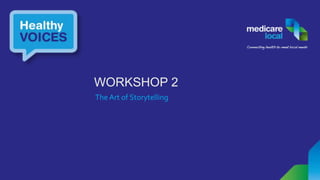Healthy Voices - The Art of Storytelling - Powerpoint
- 1. WORKSHOP 2 The Art of Storytelling
- 2. Session Two By the end of this workshop you should have the knowledge necessary to source and outline a story. You will also have developed an understanding of the roles structure and content play in good storytelling. This will be done be considering: • How to source story ideas and confirm they are appropriate? • How to outline an article • Methods for conveying concepts and ideas
- 3. SOURCING IDEAS FOR STORIES Where to look for inspiration?
- 4. Sourcing ideas for stories Your own experiences • Personal diary • http://thesecretlifeofamanicdepressive.wordpress.com/2014/01/18/withdrawal-2/ • Thoughts promoted by your day to day experiences Example: http://douglascootey.com/2014/06/adhd-fearing-failure.html • ‘How to’ articles - this is how I achieved X • Reviews of places you have visited or things you have experienced • Your memories or reminiscences
- 5. Sourcing ideas for stories Your passions: http://ww2today.com/ is a fascinating blog driven by someone’s interest inWorldWar 2. It tells what happened on this day 70 years ago. Hello Sunday morning: https://www.hellosundaymorning.org is a site seeking to change Australia’s drinking culture.
- 6. Sourcing ideas for stories Recent news or research: Sites that are dedicated providing up to date information in a particular subject areas Eg: http://dotearth.blogs.nytimes.com As a jump of point for an article in a more personal blog: http://thesecretlifeofamanicdepressive.wordpress.com/ Or as the impetus for an opinion piece on a specific issue: http://www.abc.net.au/rampup/articles/2014/06/18/4027063.htm
- 7. SHOULD YOU WRITE IT? Considerations?
- 8. Should you write it? What impact will this story have on others? Are you an appropriate person to be writing about this? Would anyone want to know what you think about this issue? What perspective do you bring to the issue? Is what you are going to write about relevant for your audience? Will you add anything new by writing on it?
- 10. OUTLINING
- 11. Outlining an Article What is an Outline? – Intro leading into a body, perhaps with subheadings, leading in turn to a conclusion. Rules: - Outlines should be: clear, concise and encapsulate the essence of the piece of work you are writing. Introductions: – Set the scene, capture attention, introduce the argument, signpost what the reader can expect. Tell them what you will tell them. Body:– Perhaps with sub headings depending on where your writing will appear. Tell them, tell them and tell them again but with nuance, style and with a tone that will keep them engaged. Conclusions: – Tell them what you’ve told them but leave them wanting more. In the case of social media invite comments
- 13. Building a story Content considerations • Using data and stats – Data is powerful but can also be unreliable and easy to manipulate. • Importancy of accuracy – Don’t Misquote, Attribute sources, check your facts • Clear, precise, easily understood language
- 14. Building a Story Content Considerations continued • One story – one idea • Sign posting: tell them what you are about to tell them and remind them what you’ve told them. • Plot development: Non fiction works can still have plot.
- 15. BUILDING A STORY Generating audience engagement
- 16. Building a story Generating audience engagement: Personalising a story – Using characters Content – writing style Accessibility AuthorsVoice: • Tone – CarolynWilson, Andrew Bolt • Humour • Language - Dickens
- 17. Building a story activity Activity - Groups to discuss example: –The Little Frenchman: http://www.acmi.net.au/dst_little_frenchman.htm in terms of: building a story, personalising a story and creating the context.
- 18. Review Today we have considered: • How to source story ideas and confirm they are appropriate? • How to outline an article • Methods for conveying concepts and ideas You should now have the knowledge necessary to source and outline a story. You should also have developed an understanding of the roles structure and content play in good storytelling.
- 19. Next Steps Tasks: 1. Access theWIKI and review this session’s material. There are many tasks throughout theWIKI. 2. Populate the parts of the project snapshot that we have covered so far: • Reasons for communicating • Story ideas 3. Outline a story, including notes capturing content considerations
- 20. Next session The Mechanic ofWriting: Defining your audience Creating a writers voice and developing your own style. The Do’s and Don’ts of writing



















